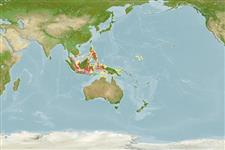Teleostei (teleosts) >
Pleuronectiformes (Flatfishes) >
Soleidae (Soles)
Etymology: Aseraggodes: Greek, aggos, -eos, -ous = vessel, uterus, carapace of a crab + Greek, aseros, -a, -on = to remove the appetite (Ref. 45335); matsuurai: Named for Keiichi Matsuura, National Museum of Nature and Science of Tokyo.
Eponymy: Dr Keiichi Matsuura works in the Department of Zoology at the National Museum of Nature and Science, Tokyo. [...] (Ref. 128868), visit book page.
More on authors: Randall & Desoutter-Meniger.
Environment: milieu / climate zone / depth range / distribution range
Ecology
Marine; demersal; depth range 0 - 18 m (Ref. 75879). Tropical
Western Pacific: Indonesia nd the Philippines.
Size / Weight / Age
Maturity: Lm ? range ? - ? cm
Max length : 5.5 cm SL male/unsexed; (Ref. 75879); 5.0 cm SL (female)
Short description
Identification keys | Morphology | Morphometrics
Collected using rotenone, one site is a drop-off point with numerous small caves and some sand and rubble (Ref. 75879)..
Life cycle and mating behavior
Maturity | Reproduction | Spawning | Eggs | Fecundity | Larvae
Randall, J.E. and M. Desoutter-Meniger, 2007. Review of the soles of the genus Aseraggodes (Pleuronectifornes: Soleidae) from the Indo-Malayan region, with descriptions of nine new species. Cybium 31(3):301-331. (Ref. 75879)
IUCN Red List Status (Ref. 130435: Version 2024-2)
Threat to humans
Harmless
Human uses
Tools
Special reports
Download XML
Internet sources
Estimates based on models
Preferred temperature (Ref.
123201): 28.5 - 29.2, mean 28.9 °C (based on 453 cells).
Phylogenetic diversity index (Ref.
82804): PD
50 = 0.5000 [Uniqueness, from 0.5 = low to 2.0 = high].
Bayesian length-weight: a=0.00977 (0.00466 - 0.02049), b=3.07 (2.90 - 3.24), in cm total length, based on LWR estimates for this (Sub)family-body shape (Ref.
93245).
Trophic level (Ref.
69278): 3.4 ±0.5 se; based on size and trophs of closest relatives
Resilience (Ref.
120179): High, minimum population doubling time less than 15 months (Preliminary K or Fecundity.).
Fishing Vulnerability (Ref.
59153): Low vulnerability (10 of 100).
